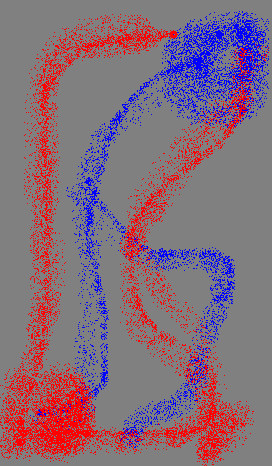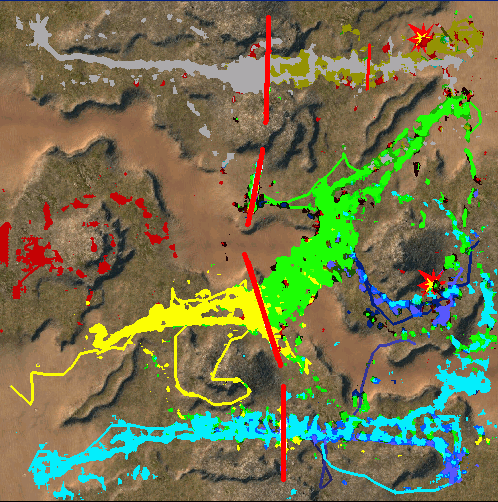knorke wrote:While the average front on Comet Catcher in your images are visible, there's plenty of space to flank and attack.
But shouldnt it look like this then:

No it shouldn't look like that, that's just random patterns moving quite independent of each other. In a real game you've got troops maneuvering against each other, striving for a good position, not moving on a set path unopposed.
And don't focus on the images so much. They don't tell the actual threats and thought processes that go on in the game. Early game movement gets totally lost in them due to lategame armies having much bigger volume, and early game is often has the most dynamic maneuvering, especially on Blue Bend which is defined by the choke points in the middle - once you reach them it's easy to secure a rigid frontline, but not before that. Compare to DSD which has you push along 2 simple lanes for the whole game, and being pushed back on this lane doesn't open new attack routes.
And you dismiss the dots in the sides much too easily, they are often the game changing stuff just as much as the roughly equal armies keeping check of each other in the middle. Oh and there will ALWAYS be a big line from base to middle, just cause that's the only sensible place to set fac rally point 90% of time.
But sure, even on CCR the game can look pretty straightforward (though I don't really approve of turning
this into
this, don't try that hard to prove your point) like in the one you made that pic of. That's just a single example though, look at the other one you linked and it's all over the map. But that's good - it means there's a very wide range of ways a game can go on that map. But even in that straightforward game there is action all over the map, which means not just more multitasking but more stuff to consider into your strategy.
It's true though that when there's more people in a game, it becomes more static by nature, but not to the extent you think it does, unless the players themselves play staticly too, which requires less coordination. Saying that a Talus game and a DSD game are very similar, is just taking it way too far. There's always more ways to attack on Talus. Yes, BA isn't a game where big armies very often drive around enemy territory, but instead it's a game where even 1 ak in the right place can do significant damage. And that sneaking ak has much better chance to find a good target on Talus than DSD. And if it's stopped, it was stopped because the opponent used his resources toward stopping these bitches.
And it's hard to say if that red line analysis of the Talus game is quite correct, without seeing the game. There was quite a bit of movement and casualties outside those redline zones, and it was a pretty short game so not enough time for very many battles. Because of wrecks, battles are often fought over the same spot repeatedly, but doesn't mean those spots would be predetermined.
About DSD, the special thing about it is not just having narrow lanes though - but that there's so little resources in those lanes. So it doesn't give that much benefit to push along it (especially in the south basin) unless you can break your way all the way through. Changing this wouldn't change the simple frontline forming though, if anything it'd force people to invest more into armies to control them.
And unpredictable is a bad word to use I think, for what you want in maps. Unpredictable is bad, it means yuo cannot properly know what will happen -> leaves things to luck. Instead there should be a wide variety of strategies that you CAN predict and adapt to.
/walloftext




